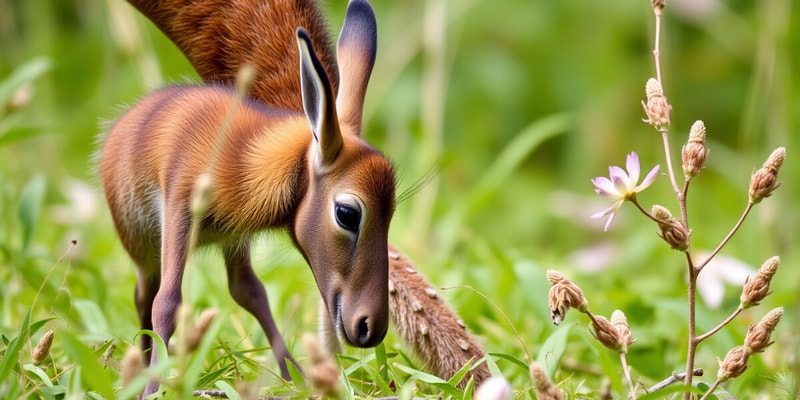Podcast
Questions and Answers
What is the effect of intermediate levels of disturbance on species richness?
What is the effect of intermediate levels of disturbance on species richness?
What is a dominant species in a community?
What is a dominant species in a community?
What best describes a keystone species?
What best describes a keystone species?
Which hypothesis suggests that a species' abundance is limited by its consumers?
Which hypothesis suggests that a species' abundance is limited by its consumers?
Signup and view all the answers
How is community regulation understood within ecological frameworks?
How is community regulation understood within ecological frameworks?
Signup and view all the answers
What is a key factor in understanding community structure according to niche dynamics?
What is a key factor in understanding community structure according to niche dynamics?
Signup and view all the answers
What occurs during a trophic cascade?
What occurs during a trophic cascade?
Signup and view all the answers
Which of the following best describes species evenness?
Which of the following best describes species evenness?
Signup and view all the answers
Which term describes the conditions within which a species can survive and thrive?
Which term describes the conditions within which a species can survive and thrive?
Signup and view all the answers
What is the term for the niche that includes all the environmental conditions a species can potentially inhabit?
What is the term for the niche that includes all the environmental conditions a species can potentially inhabit?
Signup and view all the answers
Which of the following options represents an example of niche overlap?
Which of the following options represents an example of niche overlap?
Signup and view all the answers
What does the realized niche represent in ecological terms?
What does the realized niche represent in ecological terms?
Signup and view all the answers
Which concept explains the importance of certain species in maintaining the structure of an ecosystem?
Which concept explains the importance of certain species in maintaining the structure of an ecosystem?
Signup and view all the answers
How can species richness influence community structure?
How can species richness influence community structure?
Signup and view all the answers
What might cause two species to have completely different niches although they live in the same environment?
What might cause two species to have completely different niches although they live in the same environment?
Signup and view all the answers
What is the effect of niche dynamics on species interactions within an ecosystem?
What is the effect of niche dynamics on species interactions within an ecosystem?
Signup and view all the answers
In which type of ecosystem are keystone species most likely to have a significant impact on the community structure?
In which type of ecosystem are keystone species most likely to have a significant impact on the community structure?
Signup and view all the answers
What is a likely ecological consequence of reduced species richness in a community?
What is a likely ecological consequence of reduced species richness in a community?
Signup and view all the answers
What defines species richness in a community?
What defines species richness in a community?
Signup and view all the answers
Which characteristic best describes communities that are species-poor?
Which characteristic best describes communities that are species-poor?
Signup and view all the answers
What role does a dominant species play in community structure?
What role does a dominant species play in community structure?
Signup and view all the answers
Which of the following is true about keystone species?
Which of the following is true about keystone species?
Signup and view all the answers
How do beavers influence their communities as keystone species?
How do beavers influence their communities as keystone species?
Signup and view all the answers
What distinguishes a fundamental niche from a realized niche?
What distinguishes a fundamental niche from a realized niche?
Signup and view all the answers
What is often a characteristic of high evenness in a community?
What is often a characteristic of high evenness in a community?
Signup and view all the answers
What usually happens to species composition upon the removal of a keystone species?
What usually happens to species composition upon the removal of a keystone species?
Signup and view all the answers
Which of the following describes a community dominated by few species?
Which of the following describes a community dominated by few species?
Signup and view all the answers
How can a tropical rainforest be characterized in terms of species diversity?
How can a tropical rainforest be characterized in terms of species diversity?
Signup and view all the answers
What is one consequence of a community having a high species diversity?
What is one consequence of a community having a high species diversity?
Signup and view all the answers
What is a common misconception regarding the role of dominant species?
What is a common misconception regarding the role of dominant species?
Signup and view all the answers
Which statement best defines the niche of an organism?
Which statement best defines the niche of an organism?
Signup and view all the answers
What can be inferred about communities with low evenness?
What can be inferred about communities with low evenness?
Signup and view all the answers
Study Notes
Niche
- G. Evelyn Hutchinson provided a formal definition about a niche: a multidimensional space of environmental factors that a species can tolerate, within which it lives, and to which it is well-adapted.
- Hutchinson is considered the "father of American ecology".
- A species' fundamental niche includes all the resources and conditions it can tolerate.
- A species' realized niche is the actual resources and conditions it uses due to competition.
- Niche is a multidimensional space of environmental factors.
- Figure 9.18 demonstrates one dimension of the niche by showing how a species may be limited by a particular factor, such as moisture.
- Figure 9.18 also shows how the niche can be impacted by other factors such as temperature.
- Figure 9.18 shows the "perfect" point of a niche where a species can thrive.
- Species may overlap closely along certain niche axes, but they are separated along others.
Community Composition
- Species Richness is the total number of species present in a community.
- Evenness refers to the relative abundances of species in a community.
- Species Diversity is a measure of both richness and evenness and integrates these two factors.
- Tropical Rainforests are characterized by high richness and low evenness.
- Rank Abundance is a graph that can be used to visualize evenness and includes the number of individuals from most abundant to least abundant.
Community Structure
- Many communities have dominant species at each trophic level.
- A dominant species is the most conspicuous and abundant in a community often with the highest biomass.
Keystone Species
- Keystone species have a disproportionately large effect on community structure.
- These species have outsides influence.
- Keystone species are pivotal to maintaining ecological balance.
- Removing a keystone species can significantly change community composition, resulting in the loss of other species or the unchecked growth of others.
- They are like the capstones of an arch, crucial for holding the structure together, even though they are not the largest blocks.
Keystone Species Examples
- Starfish in rocky intertidal zones have been identified as a keystone species due to their ability to control muscle populations.
- Removing starfish from the community had a significant impact on the diversity of organisms present.
- Beavers in northern forest communities are also considered keystone species.
- They change the landscape and create habitats for other species.
Niche
- Niche refers to the specific environmental factors that limit a species' distribution, growth, and reproduction.
- Fundamental Niche is the theoretical range of conditions in which a species could survive.
- Realized Niche is the actual range of conditions a species inhabits due to factors like competition.
Niche (Alternative Definitions)
- Chapter 2 describes a niche as the physical space occupied by an organism or species.
- Charles Elton described a niche as an animal's place in the biotic environment, encompassing its relationship with food and enemies, and its status within its communities.
Intermediate Disturbance Hypothesis
- Intermediate Disturbance Hypothesis suggests that species diversity is highest at intermediate levels of disturbances in a community.
- The Figure 9.32 demonstrates this hypothesis by showing how a sand-dune community can reach peak species diversity with intermediate levels of rabbit browsing.
- With low levels of disturbance, a few dominant species may take over, while with high levels of disturbance, a diverse community is unable to establish.
Top-down vs. Bottom-up
- Top-Down hypothesis, or consumer control, suggests that the abundance of a species is limited by consumers.
- A decrease in predators can lead to an increase in herbivores, leading to a decline in plants.
- Bottom-up hypothesis, or resource control, suggests that consumer abundance is determined by resource availability.
- A decrease in food can lead to a decrease in herbivores, and this decrease can influence predator populations.
Trophic Cascades
- Trophic cascades occur when changes at a higher trophic level lead to serial changes in abundance and distribution at lower levels.
- An example might be the introduction of a predator causing changes in the prey population, ripple through the community.
Summary of Community Ecology
- Richness, evenness, and diversity are key measures of community composition.
- Dominant species are important to understanding community structure.
- Keystone species have a significant impact on community structure and diversity.
- Understanding niches can help to understand community interactions.
- Community structure is regulated through top-down and bottom-up processes.
Studying That Suits You
Use AI to generate personalized quizzes and flashcards to suit your learning preferences.
Related Documents
Description
Explore the intricate relationships and dynamics within ecological communities with this quiz. You'll delve into concepts like species richness, keystone species, and niche dynamics, enhancing your understanding of biodiversity and community structure. Perfect for students of ecology and environmental science.




